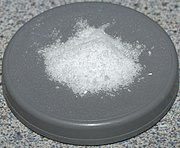 Cyclic dimer and trimer examples
| |||
| |||
| Names | |||
|---|---|---|---|
| IUPAC names
3,3-Dimethyl-1,2-dioxacyclopropane (monomer)
3,3,6,6-Tetramethyl-1,2,4,5-tetraoxane (dimer) 3,3,6,6,9,9-Hexamethyl- 3,3,6,6,9,9,12,12-Octamethyl- | |||
| Other names
Triacetone triperoxide
Peroxyacetone Mother of Satan | |||
| Identifiers | |||
3D model (JSmol)
|
| ||
| ChemSpider | |||
| E number | E929 (glazing agents, ...) | ||
PubChem CID
|
|||
| UNII | |||
CompTox Dashboard (EPA)
|
|||
| |||
| |||
| Properties | |||
| C6H12O4 (dimer) C9H18O6 (trimer) C12H24O8 (tetramer) | |||
| Molar mass | 148.157 g/mol (dimer) 222.24 g/mol (trimer) 296.296 g/mol (tetramer)[1] | ||
| Appearance | White crystalline solid | ||
| Melting point | 131.5 to 133 °C (dimer)[2] 91 °C (trimer) | ||
| Boiling point | 97 to 160 °C (207 to 320 °F; 370 to 433 K) | ||
| Insoluble | |||
| Hazards | |||
| GHS labelling: | |||
 
| |||
| NFPA 704 (fire diamond) | |||
| Explosive data | |||
| Shock sensitivity | High/High when wet | ||
| Friction sensitivity | High/moderate when wet | ||
| Detonation velocity | 5300 m/s at maximum density (1.18 g/cm3), about 2500–3000 m/s near 0.5 g/cm3 17,384 ft/s 3.29 miles per second | ||
| RE factor | 0.80 | ||
Except where otherwise noted, data are given for materials in their standard state (at 25 °C [77 °F], 100 kPa).
| |||
Acetone peroxide (/æsəˈtəʊn pɛrˈɒksaɪd/ also called APEX and mother of Satan[3][4]) is an organic peroxide and a primary explosive. It is produced by the reaction of acetone and hydrogen peroxide to yield a mixture of linear monomer and cyclic dimer, trimer, and tetramer forms. The monomer is dimethyldioxirane. The dimer is known as diacetone diperoxide (DADP). The trimer is known as triacetone triperoxide (TATP) or tri-cyclic acetone peroxide (TCAP). Acetone peroxide takes the form of a white crystalline powder with a distinctive bleach-like odor when impure, or a fruit-like smell when pure, and can explode powerfully if subjected to heat, friction, static electricity, concentrated sulfuric acid, strong UV radiation, or shock. Until about 2015, explosives detectors were not set to detect non-nitrogenous explosives, as most explosives used preceding 2015 were nitrogen-based. TATP, being nitrogen-free, has been used as the explosive of choice in several terrorist bomb attacks since 2001.
- ^ "Molar mass C12H24O8".
- ^ Federoff, Basil T. et al., Encyclopedia of Explosives and Related Items (Springfield, Virginia: National Technical Information Service, 1960), vol. 1, p. A41.
- ^ Berezow, Alex (14 November 2018). "TATP: The Chemistry of 'Mother of Satan' Explosive". American Council on Science and Health.
- ^ Swartz, Anna (24 March 2016). "What Is 'Mother of Satan'? What You Should Know About Explosive Used in Brussels Attacks". Yahoo News.


